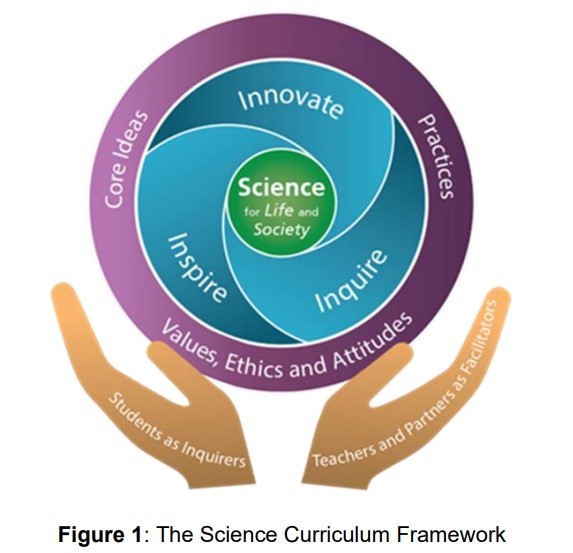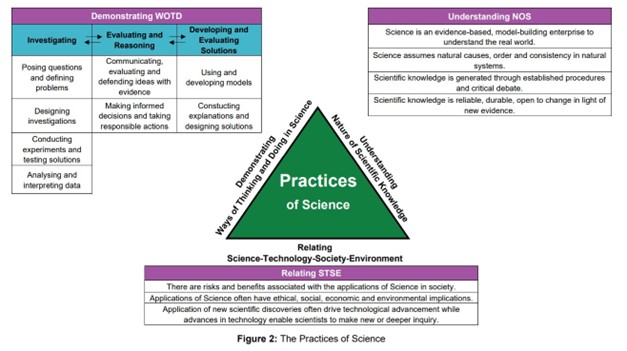Science Curriculum Framework
Science Curriculum Framework
The Science Curriculum Framework (see Figure 1) encapsulates the thrust of Science education in Singapore to provide students with a strong foundation in Science for life, learning, citizenry, and work.
Science for Life and Society in the centre circle captures the essence of the goals of Science education.

Our students are diverse, with different needs, interests, and aptitudes for Science. Given the diversity of our students and the needs of our country, the twin goals of Science education are to:
• Enthuse and nurture all students to be scientifically literate, so that they are able to make informed decisions and take responsible actions in their daily lives; and
• Provide strong Science fundamentals for students to innovate and pursue STEM for future learning and work. Surrounding the centre circle are the three “IN”s — Inspire, Inquire and Innovate — which represents the vision for Science Education and encapsulates the overall experience of our students in Science education:
(a) INspired by Science. Students enjoy learning Science and are fascinated by how everyday phenomena have scientific connections and how Science helps solve many of our global challenges. They regard Science as relevant and meaningful, appreciating how Science and Technology have transformed the world, and improved our lives. Students are open to the possibility of pursuing Science-related careers as a viable profession to serve the good of society.
(b) INquire like Scientists. Students have strong fundamentals in Science and possess the spirit of scientific inquiry. They are able to engage confidently in the Practices of Science, grounded in the knowledge, issues and questions that relate to the roles played by Science in daily life, society and the environment. They can discern, weigh alternatives, and evaluate claims and ideas critically, based on logical scientific evidence and arguments, and yet be able to suspend judgement where there is lack of evidence.
(c) INnovate using Science. Students apply Science to generate creative solutions to solve real-world problems, ranging from those affecting everyday lives to complex problems affecting humanity. It is envisaged that there will be a strong pipeline of students who can contribute towards STEM research, innovation, and enterprise.
The outer ring represents the domains that make up the strong science fundamentals: Core Ideas of Science, Practices of Science and the Values, Ethics & Attitudes in Science.
• Core Ideas of Science. The Core Ideas are the distilled ideas central to Science. The Core Ideas help students see the coherence and conceptual links within and across the different sub-disciplines of Science (i.e., Biology, Chemistry, and Physics). The Core Ideas also provide a framework to make visible students’ progression in Science understanding across the different levels of education.
• Practices of Science. The Practices consist of three components:
(a) Demonstrating Ways of Thinking and Doing in Science (WOTD);
(b) Understanding the Nature of Scientific Knowledge (NOS); and
(c) Relating Science, Technology, Society and Environment (STSE).
They represent the set of established procedures and processes associated with scientific inquiry, what scientific knowledge is and how it is generated and established, and how Science is applied in society respectively. The Practices serve to highlight that the discipline of Science is more than the acquisition of a body of knowledge (e.g., scientific facts, concepts, laws, and theories); it is also a way of thinking and doing. It is important to appreciate the three components representing the cognitive, epistemic, and social aspects of the Practices are intricately related (see Figure 2).
• Values, Ethics and Attitudes in Science. Although Science uses objective methods to arrive at evidence-based conclusions, it is in fact a human enterprise conducted in particular social contexts which involves consideration of values and ethics. The intent of fostering an awareness and appreciation of values in the curriculum is to sensitise our students to the ethical implications of the application of Science in society. Thus, Science education needs to equip students with the ability to articulate their ethical stance as they participate in discussions about socioscientific issues that involve ethical dilemmas, with no single right answer.
The pair of hands represents the roles of students as inquirers, supported by teachers and partners as facilitators of the students’ learning experiences. The partnership of learning and teaching goes beyond the students and teachers to include other partners who can facilitate learning in various contexts to help students appreciate the application of Science in their daily lives, society, and the environment.


